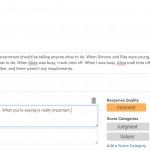This post is about two things: 1) The arbitrariness of the ways in RescueTime (and I!) define media and 2) the realization that I really need to spend far, far less time looking at screens. (Far, far less.)
I used RescueTime to track my media consumption, but then threw that data into buckets. A few attempts to wrestle through some of the questions I found interesting, below.
News, Entertainment & Social
 This first rough slice looks at three categories: the time I spent on news, social and entertainment. I used these categories because RescueTime uses them, but I already see ample space for confusion and critique. We’re already playing in somewhat arbitrary territory, in the sense that the time I spent on BuzzFeed got classified as news consumption, but could possibly have gone into entertainment (was it a listicle? Was the listicle newsworthy?). Meanwhile, BBC America went into news, but I’m pretty sure I spent those 11 minutes looking at Doctor Who action figures. On a more substantive note: there is genuine slippage between categories, here. For example, the “Entertainment” category includes all of YouTube (I didn’t track each video separately, but I almost wish I had). Part of that YouTube time was definitely informational videos about gravitational waves, and part of it was “Last Week Tonight,” a product that easily belongs in more than one category. Meanwhile, most obviously, “Social” is both news and entertainment. In an era when I’ll see Tweets about an earthquake before it appears in the news, I’m genuinely getting breaking news off social media (never mind the more hyperlocal ‘news’ about my friends’ lives.) Finally: let’s stop pretending the news and entertainment are separate. I don’t think that helps anyone.
This first rough slice looks at three categories: the time I spent on news, social and entertainment. I used these categories because RescueTime uses them, but I already see ample space for confusion and critique. We’re already playing in somewhat arbitrary territory, in the sense that the time I spent on BuzzFeed got classified as news consumption, but could possibly have gone into entertainment (was it a listicle? Was the listicle newsworthy?). Meanwhile, BBC America went into news, but I’m pretty sure I spent those 11 minutes looking at Doctor Who action figures. On a more substantive note: there is genuine slippage between categories, here. For example, the “Entertainment” category includes all of YouTube (I didn’t track each video separately, but I almost wish I had). Part of that YouTube time was definitely informational videos about gravitational waves, and part of it was “Last Week Tonight,” a product that easily belongs in more than one category. Meanwhile, most obviously, “Social” is both news and entertainment. In an era when I’ll see Tweets about an earthquake before it appears in the news, I’m genuinely getting breaking news off social media (never mind the more hyperlocal ‘news’ about my friends’ lives.) Finally: let’s stop pretending the news and entertainment are separate. I don’t think that helps anyone.
News, a Breakdown by Source
 I found this breakdown interesting. Here I’ve broken down “news” by point of origin, excluding social (ie, FB). The big green slice towards the bottom is blogs. This includes Medium and WordPress sites, and they dwarf any other individual news site. Also, I don’t know what killed news brand loyalty (search? social?) but it’s clearly dead.
I found this breakdown interesting. Here I’ve broken down “news” by point of origin, excluding social (ie, FB). The big green slice towards the bottom is blogs. This includes Medium and WordPress sites, and they dwarf any other individual news site. Also, I don’t know what killed news brand loyalty (search? social?) but it’s clearly dead.
Users Versus Big Media
 In the news and entertainment categories, I thought it would be interesting to look at media based upon who produced it. This is where it all got interesting. The clunky term “user-generated” (which still roams at large in many newsrooms) is both off-putting and, it turns out, not very useful. The “User-generated” slice here includes everything I watched on YouTube. When I think about the stuff I watch you YT, it includes a ton of Youtube cover bands, makeup tutorials (deal with it), and comedy groups. My point: I spend a lot of time consuming media on YouTube that is produced by neither Big Media nor casual users, but by some in-between professional class of producers whose only distribution mechanism is YouTube. Some of these folks are quite famous, some of them make a comfortable living off what they do on YouTube. But they’re not part of the group of producers we consider Big Media. Meanwhile, User-gen also includes Reddit, which is some strange and uncomfortable hybrid of user-generated and big media.
In the news and entertainment categories, I thought it would be interesting to look at media based upon who produced it. This is where it all got interesting. The clunky term “user-generated” (which still roams at large in many newsrooms) is both off-putting and, it turns out, not very useful. The “User-generated” slice here includes everything I watched on YouTube. When I think about the stuff I watch you YT, it includes a ton of Youtube cover bands, makeup tutorials (deal with it), and comedy groups. My point: I spend a lot of time consuming media on YouTube that is produced by neither Big Media nor casual users, but by some in-between professional class of producers whose only distribution mechanism is YouTube. Some of these folks are quite famous, some of them make a comfortable living off what they do on YouTube. But they’re not part of the group of producers we consider Big Media. Meanwhile, User-gen also includes Reddit, which is some strange and uncomfortable hybrid of user-generated and big media.
User-gen, breakdown
 This chart demonstrates the weirdness of “user-generated” as a term, still further. I’ve got content from Reddit, Blogs (Medium, Medium’s Matter publication, etc) and YouTube all jumbled together in here. None of this is produced by ‘users’ in isolation – even platforms like Reddit and YouTube enjoy massive monopolies over particular types of interaction, and they are hardly small players. They provide development, editing and interaction tools on their platforms, thereby participating in the process of content creation. Therefore, the final product, even on a site like Reddit, is partnership-generated. This content isn’t generated by professional journalists, but we (professional journalists) might be the only people who care about that distinction anymore.
This chart demonstrates the weirdness of “user-generated” as a term, still further. I’ve got content from Reddit, Blogs (Medium, Medium’s Matter publication, etc) and YouTube all jumbled together in here. None of this is produced by ‘users’ in isolation – even platforms like Reddit and YouTube enjoy massive monopolies over particular types of interaction, and they are hardly small players. They provide development, editing and interaction tools on their platforms, thereby participating in the process of content creation. Therefore, the final product, even on a site like Reddit, is partnership-generated. This content isn’t generated by professional journalists, but we (professional journalists) might be the only people who care about that distinction anymore.
News vs. Telegram
 This chart looks depressing, but it’s actually possibly vaguely heartening. Remember up top, when I said I need to spend less time with screens? That’s true, certainly, but it isn’t true that screen time =/= relationship time. In this chart, I juxtapose all the time I spent on news this week against the time I spent on Telegram, the social networking site I use the most. Here’s the interesting part: I only use Telegram to talk to a handful of friends. That means that I spent 6 hours and 52 minutes talking to approximately four friends, online. In a way, this is an homage to relationship-building, isn’t it? Even when I’m online, the #1 thing I’m doing is maintaining relationships with a core group of friends. The most interesting part of all this is that these are the four friends I probably hang out with the most in daily life, too. Interesting? Weird? Cult-ish? Maybe a bit of all three, but at least I feel a little less like an antisocial nutjob.
This chart looks depressing, but it’s actually possibly vaguely heartening. Remember up top, when I said I need to spend less time with screens? That’s true, certainly, but it isn’t true that screen time =/= relationship time. In this chart, I juxtapose all the time I spent on news this week against the time I spent on Telegram, the social networking site I use the most. Here’s the interesting part: I only use Telegram to talk to a handful of friends. That means that I spent 6 hours and 52 minutes talking to approximately four friends, online. In a way, this is an homage to relationship-building, isn’t it? Even when I’m online, the #1 thing I’m doing is maintaining relationships with a core group of friends. The most interesting part of all this is that these are the four friends I probably hang out with the most in daily life, too. Interesting? Weird? Cult-ish? Maybe a bit of all three, but at least I feel a little less like an antisocial nutjob.
Print vs. Online
 Unfortunately, I can’t find the exact quote, but a few months ago a fairly senior official at a big news publisher made headlines (Tweetlines?) by suggesting that young people will one day get tired of consuming news online and will go back to print newspapers. Whoever he is, wherever he is, this chart is for him.
Unfortunately, I can’t find the exact quote, but a few months ago a fairly senior official at a big news publisher made headlines (Tweetlines?) by suggesting that young people will one day get tired of consuming news online and will go back to print newspapers. Whoever he is, wherever he is, this chart is for him.
Video vs. the World
 This is another one of those charts I kinda struggled with, but it gets at a distinction I wanted to address. Because I’ve been using RescueTime for a while, very little of what I’ve discovered this week surprises me. That said, I was reminded just how much time I spend watching video content online. (And it’s interesting, because despite overwhelming evidence to the contrary, I still think of myself as a ‘reader’.) What’s interesting is that this statistic might actually underestimate the amount of time I spend watching video, because it doesn’t count the time I spent on, say, a Vox media page watching an embedded video on that page. (‘Video’, here, only counts time on video-specific sites like YouTube or Netflix.) This also raises really interesting questions about video distribution. BuzzFeed makes a ton of money off video. Here’s a quote from an article about their financial statements:
This is another one of those charts I kinda struggled with, but it gets at a distinction I wanted to address. Because I’ve been using RescueTime for a while, very little of what I’ve discovered this week surprises me. That said, I was reminded just how much time I spend watching video content online. (And it’s interesting, because despite overwhelming evidence to the contrary, I still think of myself as a ‘reader’.) What’s interesting is that this statistic might actually underestimate the amount of time I spend watching video, because it doesn’t count the time I spent on, say, a Vox media page watching an embedded video on that page. (‘Video’, here, only counts time on video-specific sites like YouTube or Netflix.) This also raises really interesting questions about video distribution. BuzzFeed makes a ton of money off video. Here’s a quote from an article about their financial statements:
“You have to remember,” Dempsey added, “that BuzzFeed doesn’t operate on any sort of subscription model, is growing at a significantly higher rate versus traditional media companies, and also is doing a lot in their original video content, which is largely viewed outside of BuzzFeed.com, almost making this part of the business more comparable to an original content company vs. digital media publication.”
Part of winning the video play, at least if you’re taking a page out of the BuzzFeed playbook (and who isn’t, these days?), is being seen on aggregators like YouTube and Netflix. How many news publishers are serious about building audience on YouTube (I know what you’re thinking: does John Oliver count?) Meanwhile, if you search Netflix for news, what do you get? Nothing at all.
Note: if the image quality on these charts is lame, I’ve got higher resolution pdfs I can share.















 This first rough slice looks at three categories: the time I spent on news, social and entertainment. I used these categories because RescueTime uses them, but I already see ample space for confusion and critique. We’re already playing in somewhat arbitrary territory, in the sense that the time I spent on BuzzFeed got classified as news consumption, but could possibly have gone into entertainment (was it a listicle? Was the listicle newsworthy?). Meanwhile, BBC America went into news, but I’m pretty sure I spent those 11 minutes looking at Doctor Who action figures. On a more substantive note: there is genuine slippage between categories, here. For example, the “Entertainment” category includes all of YouTube (I didn’t track each video separately, but I almost wish I had). Part of that YouTube time was definitely informational videos about gravitational waves, and part of it was “Last Week Tonight,” a product that easily belongs in more than one category. Meanwhile, most obviously, “Social” is both news and entertainment. In an era when I’ll see Tweets about an earthquake before it appears in the news, I’m genuinely getting breaking news off social media (never mind the more hyperlocal ‘news’ about my friends’ lives.) Finally: let’s stop pretending the news and entertainment are separate. I don’t think that helps anyone.
This first rough slice looks at three categories: the time I spent on news, social and entertainment. I used these categories because RescueTime uses them, but I already see ample space for confusion and critique. We’re already playing in somewhat arbitrary territory, in the sense that the time I spent on BuzzFeed got classified as news consumption, but could possibly have gone into entertainment (was it a listicle? Was the listicle newsworthy?). Meanwhile, BBC America went into news, but I’m pretty sure I spent those 11 minutes looking at Doctor Who action figures. On a more substantive note: there is genuine slippage between categories, here. For example, the “Entertainment” category includes all of YouTube (I didn’t track each video separately, but I almost wish I had). Part of that YouTube time was definitely informational videos about gravitational waves, and part of it was “Last Week Tonight,” a product that easily belongs in more than one category. Meanwhile, most obviously, “Social” is both news and entertainment. In an era when I’ll see Tweets about an earthquake before it appears in the news, I’m genuinely getting breaking news off social media (never mind the more hyperlocal ‘news’ about my friends’ lives.) Finally: let’s stop pretending the news and entertainment are separate. I don’t think that helps anyone. I found this breakdown interesting. Here I’ve broken down “news” by point of origin, excluding social (ie, FB). The big green slice towards the bottom is blogs. This includes Medium and WordPress sites, and they dwarf any other individual news site. Also, I don’t know what killed news brand loyalty (search? social?) but it’s clearly dead.
I found this breakdown interesting. Here I’ve broken down “news” by point of origin, excluding social (ie, FB). The big green slice towards the bottom is blogs. This includes Medium and WordPress sites, and they dwarf any other individual news site. Also, I don’t know what killed news brand loyalty (search? social?) but it’s clearly dead. In the news and entertainment categories, I thought it would be interesting to look at media based upon who produced it. This is where it all got interesting. The clunky term “user-generated” (which still roams at large in many newsrooms) is both off-putting and, it turns out, not very useful. The “User-generated” slice here includes everything I watched on YouTube. When I think about the stuff I watch you YT, it includes a ton of Youtube cover bands, makeup tutorials (deal with it), and comedy groups. My point: I spend a lot of time consuming media on YouTube that is produced by neither Big Media nor casual users, but by some in-between professional class of producers whose only distribution mechanism is YouTube. Some of these folks are quite famous, some of them make a comfortable living off what they do on YouTube. But they’re not part of the group of producers we consider Big Media. Meanwhile, User-gen also includes Reddit, which is some strange and uncomfortable hybrid of user-generated and big media.
In the news and entertainment categories, I thought it would be interesting to look at media based upon who produced it. This is where it all got interesting. The clunky term “user-generated” (which still roams at large in many newsrooms) is both off-putting and, it turns out, not very useful. The “User-generated” slice here includes everything I watched on YouTube. When I think about the stuff I watch you YT, it includes a ton of Youtube cover bands, makeup tutorials (deal with it), and comedy groups. My point: I spend a lot of time consuming media on YouTube that is produced by neither Big Media nor casual users, but by some in-between professional class of producers whose only distribution mechanism is YouTube. Some of these folks are quite famous, some of them make a comfortable living off what they do on YouTube. But they’re not part of the group of producers we consider Big Media. Meanwhile, User-gen also includes Reddit, which is some strange and uncomfortable hybrid of user-generated and big media. This chart demonstrates the weirdness of “user-generated” as a term, still further. I’ve got content from Reddit, Blogs (Medium, Medium’s Matter publication, etc) and YouTube all jumbled together in here. None of this is produced by ‘users’ in isolation – even platforms like Reddit and YouTube enjoy massive monopolies over particular types of interaction, and they are hardly small players. They provide development, editing and interaction tools on their platforms, thereby participating in the process of content creation. Therefore, the final product, even on a site like Reddit, is partnership-generated. This content isn’t generated by professional journalists, but we (professional journalists) might be the only people who care about that distinction anymore.
This chart demonstrates the weirdness of “user-generated” as a term, still further. I’ve got content from Reddit, Blogs (Medium, Medium’s Matter publication, etc) and YouTube all jumbled together in here. None of this is produced by ‘users’ in isolation – even platforms like Reddit and YouTube enjoy massive monopolies over particular types of interaction, and they are hardly small players. They provide development, editing and interaction tools on their platforms, thereby participating in the process of content creation. Therefore, the final product, even on a site like Reddit, is partnership-generated. This content isn’t generated by professional journalists, but we (professional journalists) might be the only people who care about that distinction anymore. This chart looks depressing, but it’s actually possibly vaguely heartening. Remember up top, when I said I need to spend less time with screens? That’s true, certainly, but it isn’t true that screen time =/= relationship time. In this chart, I juxtapose all the time I spent on news this week against the time I spent on Telegram, the social networking site I use the most. Here’s the interesting part: I only use Telegram to talk to a handful of friends. That means that I spent 6 hours and 52 minutes talking to approximately four friends, online. In a way, this is an homage to relationship-building, isn’t it? Even when I’m online, the #1 thing I’m doing is maintaining relationships with a core group of friends. The most interesting part of all this is that these are the four friends I probably hang out with the most in daily life, too. Interesting? Weird? Cult-ish? Maybe a bit of all three, but at least I feel a little less like an antisocial nutjob.
This chart looks depressing, but it’s actually possibly vaguely heartening. Remember up top, when I said I need to spend less time with screens? That’s true, certainly, but it isn’t true that screen time =/= relationship time. In this chart, I juxtapose all the time I spent on news this week against the time I spent on Telegram, the social networking site I use the most. Here’s the interesting part: I only use Telegram to talk to a handful of friends. That means that I spent 6 hours and 52 minutes talking to approximately four friends, online. In a way, this is an homage to relationship-building, isn’t it? Even when I’m online, the #1 thing I’m doing is maintaining relationships with a core group of friends. The most interesting part of all this is that these are the four friends I probably hang out with the most in daily life, too. Interesting? Weird? Cult-ish? Maybe a bit of all three, but at least I feel a little less like an antisocial nutjob. Unfortunately, I can’t find the exact quote, but a few months ago a fairly senior official at a big news publisher made headlines (Tweetlines?) by suggesting that young people will one day get tired of consuming news online and will go back to print newspapers. Whoever he is, wherever he is, this chart is for him.
Unfortunately, I can’t find the exact quote, but a few months ago a fairly senior official at a big news publisher made headlines (Tweetlines?) by suggesting that young people will one day get tired of consuming news online and will go back to print newspapers. Whoever he is, wherever he is, this chart is for him. This is another one of those charts I kinda struggled with, but it gets at a distinction I wanted to address. Because I’ve been using RescueTime for a while, very little of what I’ve discovered this week surprises me. That said, I was reminded just how much time I spend watching video content online. (And it’s interesting, because despite overwhelming evidence to the contrary, I still think of myself as a ‘reader’.) What’s interesting is that this statistic might actually underestimate the amount of time I spend watching video, because it doesn’t count the time I spent on, say, a Vox media page watching an embedded video on that page. (‘Video’, here, only counts time on video-specific sites like YouTube or Netflix.) This also raises really interesting questions about video distribution. BuzzFeed makes a ton of money off video. Here’s a quote from an
This is another one of those charts I kinda struggled with, but it gets at a distinction I wanted to address. Because I’ve been using RescueTime for a while, very little of what I’ve discovered this week surprises me. That said, I was reminded just how much time I spend watching video content online. (And it’s interesting, because despite overwhelming evidence to the contrary, I still think of myself as a ‘reader’.) What’s interesting is that this statistic might actually underestimate the amount of time I spend watching video, because it doesn’t count the time I spent on, say, a Vox media page watching an embedded video on that page. (‘Video’, here, only counts time on video-specific sites like YouTube or Netflix.) This also raises really interesting questions about video distribution. BuzzFeed makes a ton of money off video. Here’s a quote from an 